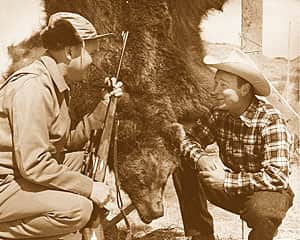History of Weatherby: Roy Weatherby, the Ultimate Tinkerer
Laurie Lee Dovey 07.01.11

African safaris were considered an extreme sport in the late 1940s and early ‘50s. Most Americans could only dream of experiencing the mysterious world of the kudu, elephant, zebra and rhinoceros. Roy Weatherby’s 50-day hunting sojourn in 1948, which he chronicled on newsreel footage and brought back to the states, gave Americans rare, real-life glimpses of exotic lands and big game never before seen.
Weatherby’s love of hunting was a by-product of his hobbyist nature. He was the ultimate tinkerer. From lapidary to crafting model airplanes to designing rifle cartridges, his interests were wide ranging. The latter changed his life, defined him professionally, resulted in his characterization as a groundbreaker and free thinker, and positively impacted the firearms industry.
High-Velocity, Light-Weight Bullets
At a time when many firearms experts, like Elmer Keith, were promoting big bullets traveling at slow speeds, Weatherby experimented with lighter weight bullets that traveled at extremely high velocities. He believed the combination was ideal for the flat-shooting, hard-hitting power needed to create enough hydrostatic shock to kill animals quickly and humanely.
“At the time, Roy was quite controversial,” explained Brad Ruddell, vice president of sales and marketing for Weatherby. “His beliefs were often the subject of debate with folks like Keith and noted gun writer Jack O’Connor.”
Weatherby was able to found a fledgling cartridge and firearms business in 1945 by working as a salesman for an auto club and by establishing a retail gun shop in Los Angeles.
Initially, Weatherby developed the .220 Rocket (based on the .220 Swift), and the first Weatherby Magnums – .257, .270 and .300 (based on the .300 H&H Mag.). He also built his own rifles on virtually any action he could obtain, such as the FN Mauser, Schultz & Larsen and Mathieus. He also offered to rechamber rifles for his newly designed magnum calibers.
“Weatherby cartridges were substantially hotter than other rounds at the time, and the performance increases were impressive,” explained noted gun writer/broadcaster Tom Gresham, who co-authored the Weatherby biography, “Weatherby: The Man, The Gun, The Legend”, with his father, the late Grits Gresham.
“The standard 30-caliber hunting round was the .30-06, which was considered a big cartridge. Few used the .300 H&H Magnum. The .300 Weatherby Magnum was hotter, louder, shot farther and hit harder than anything anyone had seen.”
Mark V Magnum Action
By the mid-to-late 1950s, Weatherby had expanded his line of magnum cartridges to include the .378 Weatherby Magnum and the .460, the world’s most powerful production cartridge, delivering nearly four tons of muzzle energy. In 1957, he again commanded the spotlight with the unveiling of the action recognized around the world today as the Mark V Magnum Action
“Roy Weatherby knew rifles and his role as high-velocity pioneer is important,” Gresham reported. “But, I think Roy’s most important contribution was modern marketing. He changed the way guns are marketed. He proved that you could sell higher-priced rifles than other companies thought possible, if you created a demand.
“He redesigned a rifle to put California styling on it. We’re accustomed to that now, but at the time rifles came with dull, oil finishes. He put rakish lines on the stock and used high-gloss finishes. I wonder if there will be another Roy Weatherby.”
John Wayne to John Doe
Weatherby’s marketing genius found him dealing with the upper echelon of the firearms industry, the world’s most noted shooters and hunters, and numerous celebrities. Brushing elbows with the rich and famous and Hollywood mega stars like John Wayne became part of the Weatherby mystique.
Despite his involvement with the moneyed sector, Weatherby didn’t lose sight of the average consumer. This was clearly evidenced in the early 70s when the Vanguard – a rifle that offered Weatherby accuracy and performance at a more affordable price – was introduced.
Roy Weatherby passed away in 1988, but his visions are carried forward by his son, Roy “Ed” Weatherby, Jr. Ed isn’t the task-oriented person his father was. He’s a skilled people person and delegator, which serves his 21st century company well.
According to Ruddell, Ed sets the vision for where he wants the company to go, then gives the competent people who surround him the autonomy to accomplish the vision.
Practically every person at Weatherby, from the gals in the customer service and credit departments thorough the executive ranks, hunts or shoots. They’re enthusiasts and their intimate connection to the shooting sports and understanding of the consumer are evident in the product offerings and level of customer service provided.

